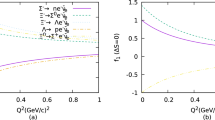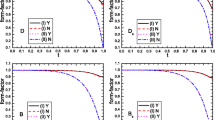Summary
The framework of ref. (1) is applied to study the decays K→ππ. The same Hamiltonian is used as the one which applies for nonleptonic hyperon decays. Without further assumptions, all decay amplitudes are calculated and expressed in terms of five parameters. Three relations between the amplitudes are obtained. Comparison is made with experiment and with related work by other authors.
Riassunto
Si applica lo schema del ref. (1) allo studio del decadimento K→ππ. Si usa un hamiltoniano uguale a quello adatto per decadimenti non leptonici di iperoni. Senza ulteriori ipotesi, si calcolano tutte le ampiezze di decadimento in funzione di cinque parametri. Si fa un confronto con gli esperimenti e con gli articoli correlativi di altri autori.
Similar content being viewed by others
References
P. Roman andS. K. Yun:Nuovo Cimento,44 A, 1091 (1966). This paper will be quoted in the following as paper I.
T. D. Lee:Phys. Rev.,140, B, 959 (1965). See also theProceedings of the Oxford International Conference on Elementary Particles, Sept. 1965.
In fact, the octet hypothesis is even far stronger an assumption than the ΔI=1/2 rule.
We shall study the effect of a non-C s-invariantH γ in a later paper.
In the present work we also disregarded a possible 27-term inH w,just as we did in paper I. Such a term would contribute to both ΔI=1/2 and 3/2, but it is not needed in a minimal form ofH w
J. J. de Swart:Rev. Mod. Phys.,3–5, 916 (1963).
P. McNamee andF. Chilton:Rev. Mod. Phys.,36, 1005 (1964).
The experimental values for decay amplitudes have been calculated from the mean life and branching ratio data given inA. H. Rosenfeld, A. Barbaro-Galtieri, W. H. Barkas, P. L. Bastien, J. Kirz andM. Roos:Rev. Mod. Phys.,37, 633 (1965). We note that because of the intrinsicT-invariance of our theory, the first-order decay amplitudes are real, so that when taking the square root of the experimental decay rates, the only ambiguity is a ± sign.
T. Das andK. T. Mahanthappa: University of Pennsylvania Preprint, Sept. 1965.
Incidentally, it appears to us that for the very same reason their prediction of the axialD/F ratio is so close to our prediction in paper I.
E. C. G. Sudarshan: Syracuse University Preprint 1206-SU-41, Oct. 1965.
S. N. Biswas, S. K. Bose andV. S. Mathur:Phys. Rev.,139, B 132 (1965).
Note added in proof.—Problems related to the present paper have been recently discussed also byS. P. Rosen:Phys. Rev.,143, 1388 (1966) and byS. P. Rosen, S. Pakvasa andE. C. G. Sudarshan: Syracuse University Preprint, 1206-SU-46.
Author information
Authors and Affiliations
Additional information
Research sponsored by the U.S. Air Force under Grant No. AF-AFOSR-385-65.
Traduzione a cura della Redazione.
Rights and permissions
About this article
Cite this article
Roman, P., Yun, S.K. Two-pion decays of kaons in a novel approach to nonleptonic weak processes. Nuovo Cimento A (1965-1970) 44, 1110–1119 (1966). https://doi.org/10.1007/BF02719353
Received:
Published:
Issue Date:
DOI: https://doi.org/10.1007/BF02719353




